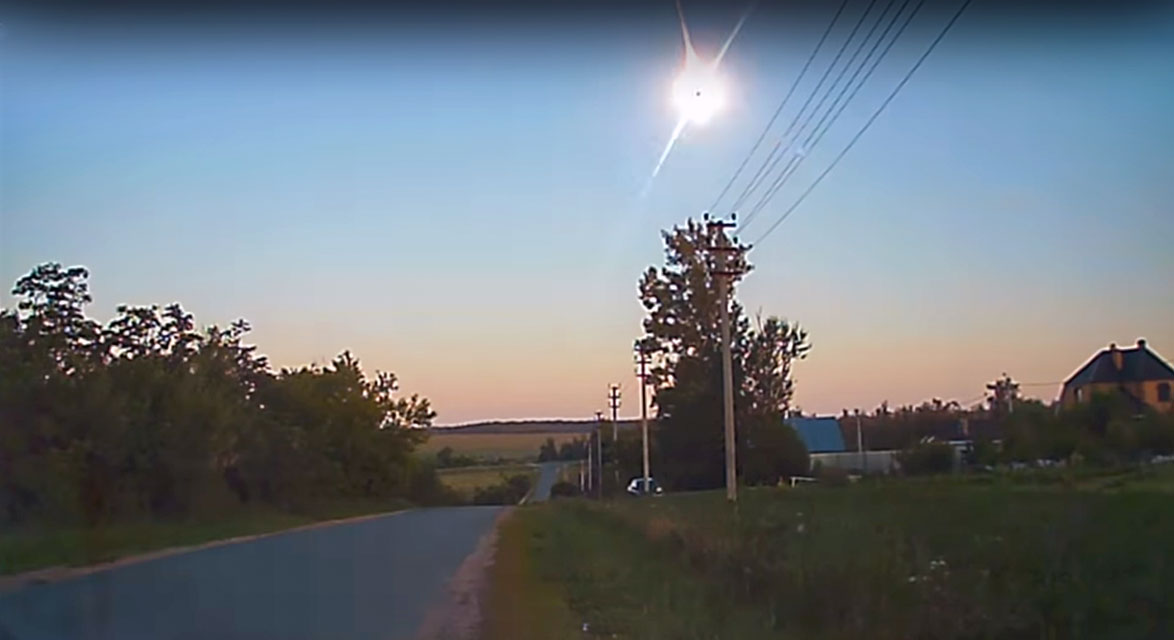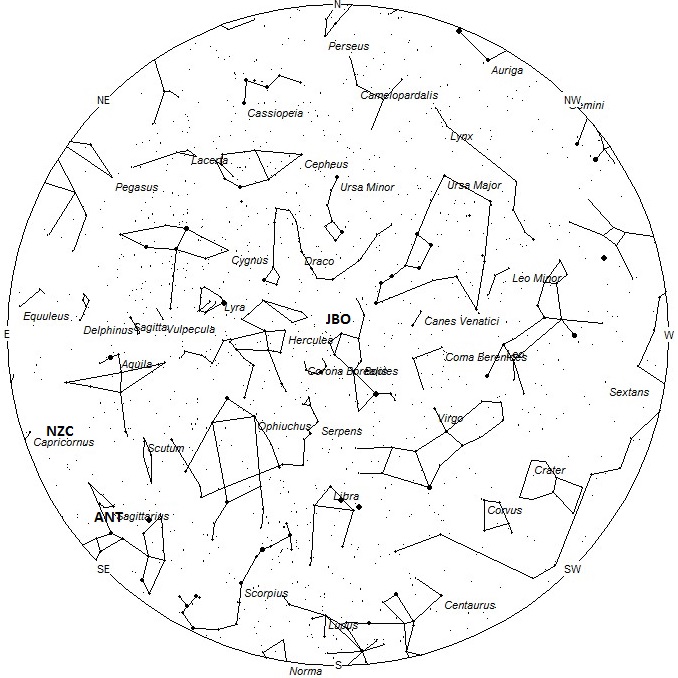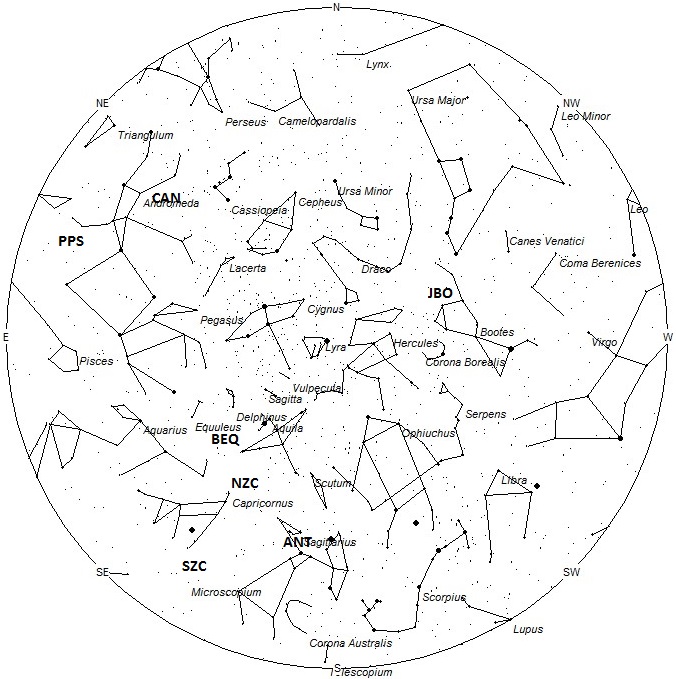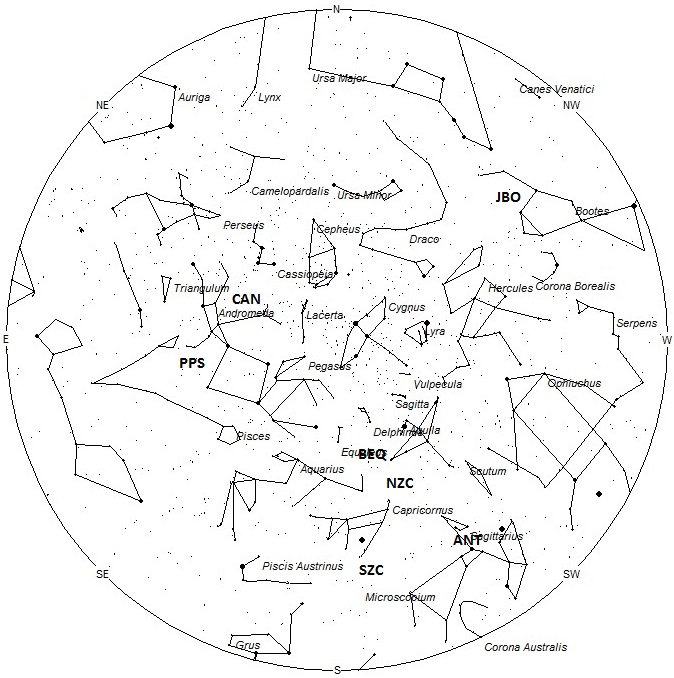
During this period the moon will reach it’s full phase on Thursday June 28th. At that time the moon will be located opposite the sun and will lie above the horizon most of the night. This weekend the waxing gibbous moon will set prior to dawn allowing a short look at the morning activity before the sky becomes too bright for viewing. The estimated total hourly meteor rates for evening observers this week is 2 as seen from mid-northern latitude (45N) and 3 from the southern tropics (25S). For morning observers the estimated total hourly rates should be near 10 as seen from mid-northern latitudes (45N) and 13 from the southern tropics (25S). Evening rates are reduced due to interfering moonlight. The actual rates will also depend on factors such as personal light and motion perception, local weather conditions, alertness and experience in watching meteor activity. Note that the hourly rates listed below are estimates as viewed from dark sky sites away from urban light sources. Observers viewing from urban areas will see less activity as only the brighter meteors will be visible from such locations.
The radiant (the area of the sky where meteors appear to shoot from) positions and rates listed below are exact for Saturday night/Sunday morning June 23/24. These positions do not change greatly day to day so the listed coordinates may be used during this entire period. Most star atlases (available at science stores and planetariums) will provide maps with grid lines of the celestial coordinates so that you may find out exactly where these positions are located in the sky. A planisphere or computer planetarium program is also useful in showing the sky at any time of night on any date of the year. Activity from each radiant is best seen when it is positioned highest in the sky, either due north or south along the meridian, depending on your latitude. It must be remembered that meteor activity is rarely seen at the radiant position. Rather they shoot outwards from the radiant so it is best to center your field of view so that the radiant lies near the edge and not the center. Viewing there will allow you to easily trace the path of each meteor back to the radiant (if it is a shower member) or in another direction if it is a sporadic. Meteor activity is not seen from radiants that are located far below the horizon. The positions below are listed in a west to east manner in order of right ascension (celestial longitude). The positions listed first are located further west therefore are accessible earlier in the night while those listed further down the list rise later in the night.
These sources of meteoric activity are expected to be active this week.
The June Bootids (JBO) are usually a very weak shower that occasionally produces outbursts. Nothing out of the ordinary is expected this year. These meteors are best seen from June 23-25 with maximum activity occurring on the 24th. At maximum the radiant is located at 14:58 (224) +48. This position lies in northwestern Bootes, 15 degrees east of the second magnitude star known as Alkaid (Eta Ursae Majoris). This radiant is best placed in the evening sky just as the sky becomes dark. Observers in the northern hemisphere have a distinct advantage over those located south of the equator as the radiant lies much higher in the evening sky. No matter your location, little activity is expected from this source. With an entry velocity of 18 km/sec., the average June Bootid meteor would be of very slow velocity.
The center of the large Anthelion (ANT) radiant is currently located at 18:32 (285) -23. This position lies north-central Sagittarius, 4 degrees north of the 2nd magnitude star known as Nunki (sigma Sagittarii). This radiant is best placed near 0200 local daylight saving time (LDT), when it lies on the meridian and is located highest in the sky. Hourly rates at this time should be near 2 as seen from mid-northern latitudes and 3 as seen from tropical southern latitudes. With an entry velocity of 30 km/sec., the average Anthelion meteor would be of slow velocity.
The Northern June Aquilids (NZC) are active from a radiant located at 20:04 (301) -08. This area of the sky is located in southeastern Aquila, 5 degrees northwest of the 4th magnitude naked eye double star known as Algedi (alpha Capricornii). This radiant is best placed near 0300 LDT, when it lies on the meridian and is located highest in the sky. With the July 3rd maximum still a week away, hourly rates at this time will be near 1 no matter your location. With an entry velocity of 38 km/sec., the average meteor from this source would be of medium-slow velocity.
The Southern June Aquilids (SZC) were discovered by G. Gartrell and W. G. Elford, in their study of Southern Hemisphere meteor streams. This stream is active from June 9 through July 17 with maximum activity occurring on July 6. The radiant is currently located at 20:27 (307) -31. This area of the sky is actually located in western Microscopium, 6 degrees southwest of the 4th magnitude star known as omega Capricornii. This radiant is best placed near 0300 LDT, when it lies on the meridian and is located highest in the sky. With the July 6th maximum still 2 weeks away, hourly rates at this time will be less than 1 no matter your location. With an entry velocity of 39 km/sec., the average meteor from this source would be of medium-slow velocity. This radiant is synonymous with the Microscopiids.
The beta Equulids (BEQ) were discovered by Dr. Peter Brown and associates using data from the Canadian Meteor Orbit Radar (CMOR) installation. These meteors are active from June 7-30 with maximum activity occurring on June 14th. The radiant position currently lies at 20:40 (310) +02. This area of the sky lies in in extreme northwestern Aquarius, 2 degrees north of the faint star known as 71 Aquarii. The brighter 3rd magnitude star known as Tseen Foo (theta Aquilae) lies 7 degrees to the southwest. These meteors are best seen near during the last dark hour of the night when the radiant lies highest in a dark sky. Hourly rates are expected to be less than 1. With an entry velocity of 33 kilometers per second, a majority of these meteors will appear to move with medium-slow velocities.
The phi Piscids (PPS) are another discovery by Dr. Peter Brown and associates using data from the Canadian Meteor Orbit Radar (CMOR) installation. These meteors are active from June 8-August 02 with maximum activity occurring on July 5th. The radiant position currently lies at 00:30 (007) +21. This area of the sky lies in north-central Pisces. The nearest star of note is the faint star known as eta Andromedae, which lies 4 degrees to the northeast. These meteors are best seen near during the last dark hour of the night when the radiant lies highest in a dark sky. Hourly rates are expected to be less than 1. With an entry velocity of 67 kilometers per second, a majority of these meteors will appear to move with swift velocities.
The first of the c-Andromedids (CAN) should be seen this week. This stream was discovered by Sirko Molau and Juergen Rendtel using video data from the IMO network. Activity from this source is seen from June 26 though July 27 with maximum activity occurring on July 9. The radiant currently lies at 00:54 (013) +43, which places it in northern Andromeda, just 2 degrees north of the faint star known as nu Andromedae. This position is also just 2 degrees northeast of the naked eye Andromeda Galaxy. This area of the sky is best seen during the last dark hour before dawn when the radiant lies highest in a dark sky. Observers in the northern hemisphere are better situated to view this activity as the radiant rises much higher in the sky before dawn compared to southern latitudes. Current rates would be less than 1 per hour no matter your location. With an entry velocity of 58 km/sec., the average meteor from this source would be of swift velocity.
As seen from the mid-northern hemisphere (45N) one would expect to see approximately 7 sporadic meteors per hour during the last hour before dawn as seen from rural observing sites. Evening rates would be near 1 per hour. As seen from the tropical southern latitudes (25S), morning rates would be near 9 per hour as seen from rural observing sites and 2 per hour during the evening hours. Locations between these two extremes would see activity between the listed figures. Evening rates during this period are reduced due to moonlight.
The list below offers the information from above in tabular form. Rates and positions are exact for Saturday night/Sunday morning except where noted in the shower descriptions.
| SHOWER | DATE OF MAXIMUM ACTIVITY | CELESTIAL POSITION | ENTRY VELOCITY | CULMINATION | HOURLY RATE | CLASS |
| RA (RA in Deg.) DEC | Km/Sec | Local Daylight Saving Time | North-South | |||
| June Bootids (JBO) | Jun 24 | 14:58 (224) +48 | 18 | 22:00 | <1 – <1 | III |
| Anthelion (ANT) | – | 18:32 (278) -23 | 30 | 02:00 | 2 – 3 | II |
| Northern June Aquilids (NZC) | Jul 03 | 19:40 (295) -10 | 38 | 03:00 | 1 – 1 | IV |
| Southern June Aquilids (SZC) | Jul 06 | 19:58 (299) -33 | 39 | 03:00 | <1 – <1 | IV |
| beta Equulids (BEQ) | Jun 14 | 20:16 (304) +01 | 33 | 03:00 | <1 – <1 | IV |
| phi Piscids (PPS) | Jul 05 | 00:08 (002) +18 | 67 | 07:00 | <1 – <1 | IV |
| c-Andromedids (CAN) | Jul 09 | 00:54 (013) +43 | 58 | 08:00 | <1 – <1 | IV |
 American Meteor Society
American Meteor Society



I saw what looked like 2 meteors at approx 04:40 today. I am in Milton Keynes and saw them off to the East. Might they have been meteors? I took a picture and saw they had long trails, were travelling at the same speed and in the same direction.
Maggie,
If you had time to take a picture, they probably were satellites and not meteors. Meteors only last a second or two before they disintegrate high in the atmosphere.
Robert Lunsford
Seen a big green shooting start type thing in the sky lastnight. It was quite big and very fast only got a glimpse of it for a moment no idea what it was.
Elliot lake, ON Canada
Just caught a glimpse of a comet or fireball shooting down San Diego at approximately 20:30. It emitted a green light and disappeared after 2 seconds.
What hit the Florida sky’s: My family and I was headed to the airport this morning. Around 6am we saw in the sky what looked to be a comet or something my husband loves space and took a video but he seems to think it was NASA doing something but I swear it looked like a comet so can anyone tell me what we saw it was pretty big and we had absolutely no problem seeing it whoever was outside at the time had to see it and hear it we saw it coming through the sky for awhile before we heard the rumble behind it
Both myself and my wife saw a meteor low in western sky around 6:30pm while Sun still up in the Madison AL area. Roughly 15 degrees above horizon heading south toward setting Sun. Bright enough to see through Sun light setting! B